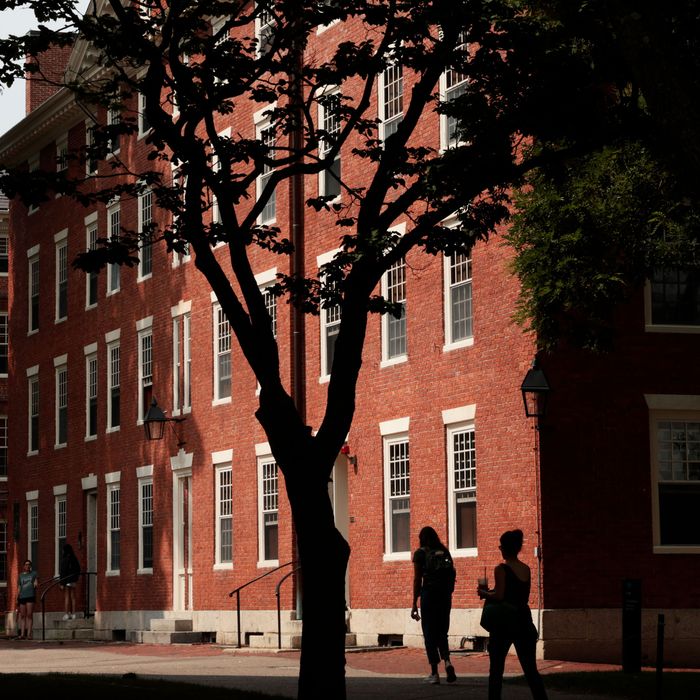
Abysmal math grades and a lack of family money kept me out of the Ivy League. Now I am a professional writer, but everyone around me is still talking about college — not just any kind of college, but Harvard, Yale, and the like. (Legacy media is often run by elite college graduates.) Though I’d like to ignore the Ivy League the rest of my life, I can’t: The Ivy League produces our ruling class. What happens there concerns us all, even if you didn’t attend college. A recent Supreme Court ruling brought that reality into focus.
With SFFA v. Harvard and SFFA v. UNC, the conservative court struck down affirmative-action programs that consider race in college admissions. In the court’s wake, the nation’s top colleges have had to consider a difficult question: Is equality possible without affirmative action? One answer is to end legacy admissions, which privilege the white and well-connected over everyone else. Wesleyan University has announced that it will no longer consider legacy status in admissions. The Education Department even entered the debate and is investigating Harvard over whether the practice is discriminatory. The end of legacy admissions is newly plausible, and that is a victory. Yet the road to equality is long. Elite colleges could end legacy admissions tomorrow, en masse, and meritocracy would remain a fiction.
Affirmative action opened new routes to the ruling class for racial minorities, but it was a bandage on an open wound. Our top colleges reinforce deep social dysfunction on purpose. That’s one takeaway from a recent study produced by Opportunity Insights, a team at Harvard. According to the New York Times, researchers examined federal college-attendance records and parental income taxes “for nearly all college students” from 1999 to 2015, in addition to standardized test scores from 2001 to 2015 and the admissions data of at least three unnamed elite institutions. By focusing on the Ivy League plus Stanford, Duke, MIT, and the University of Chicago, they produced an illuminating — and unflattering — portrait of elite-college admissions. “The new data shows that among students with the same test scores, the colleges gave preference to the children of alumni and to recruited athletes, and gave children from private schools higher nonacademic ratings,” the Times reported. Susan Dynarski, an economist at the Harvard Graduate School of Education, told the newspaper: “What I conclude from this study is the Ivy League doesn’t have low-income students because it doesn’t want low-income students.”
Why might the Ivy League prefer the wealthy? At Jacobin, Matt Bruenig offered a compelling theory. “If they wanted to create classes that were more socioeconomically balanced, they could already do so from their current applicant pool,” he wrote. “They choose not to because their goal is, in part, to run the nation’s elite families through their institutions in order to increase their endowments and power in society.” This isn’t some shadowy conspiracy. It’s how class warfare works in the open. The ruling class must be trained somewhere and Harvard is here to oblige.
We can and should take steps to make the Ivy League a more equitable place. Ending legacy admissions is a start, though there’s more to do. Athletic recruitment and nonacademic considerations also keep diverse students out of school. But we have to be honest about the limitations of such measures. Wealthy students will always have an advantage in selective college admissions. They have access to tutors, and more advanced courses, and the social connections it takes to succeed. Even if schools stop considering legacy status as an official factor in admissions, wealthy students are much more likely to know what elite schools look for and how they work. Familiarity is its own power.
I joked recently that we should abolish the Ivy League. Though I’m not convinced that’s such a terrible idea, I understand that it’s unlikely. In lieu of its destruction, we might consider a greater investment in our public colleges and universities. The need is there. In 2019, the Center for Budget and Policy Priorities reported that “overall state funding for public two- and four-year colleges in the school year ending in 2018 was more than $6.6 billion below what it was in 2008,” adjusting for inflation. Later, a 2022 report from the National Education Association found that “32 states spent less on public colleges and universities in 2020 than in 2008, with an average decline of nearly $1,500 per student.” Funding shortfalls can help lead to higher tuition for students, which places college out of reach for many — unless they want to take on debt.
Wealthy students aren’t just more likely to get into Harvard. They also don’t have to worry about the crushing financial cost of college. The rest of us are less fortunate, despite recent efforts at change. Answering calls from progressive activists, Senator Bernie Sanders once ran for president on tuition-free public college and the cancellation of all student-loan debt. Now the Biden administration is trying to relieve some student debt, thanks largely to pressure from the left. Even so, progress is hampered by centrist imaginations and legal challenges from the right: The administration’s plans would leave a lot of debt intact, and they wouldn’t relieve the conditions behind the debt.
The Ivy League is grotesque, but so is the state of American higher education. Elite campuses replicate in miniature the inequalities that afflict us as a nation. Students deserve a fairer admissions process and so much more.





























